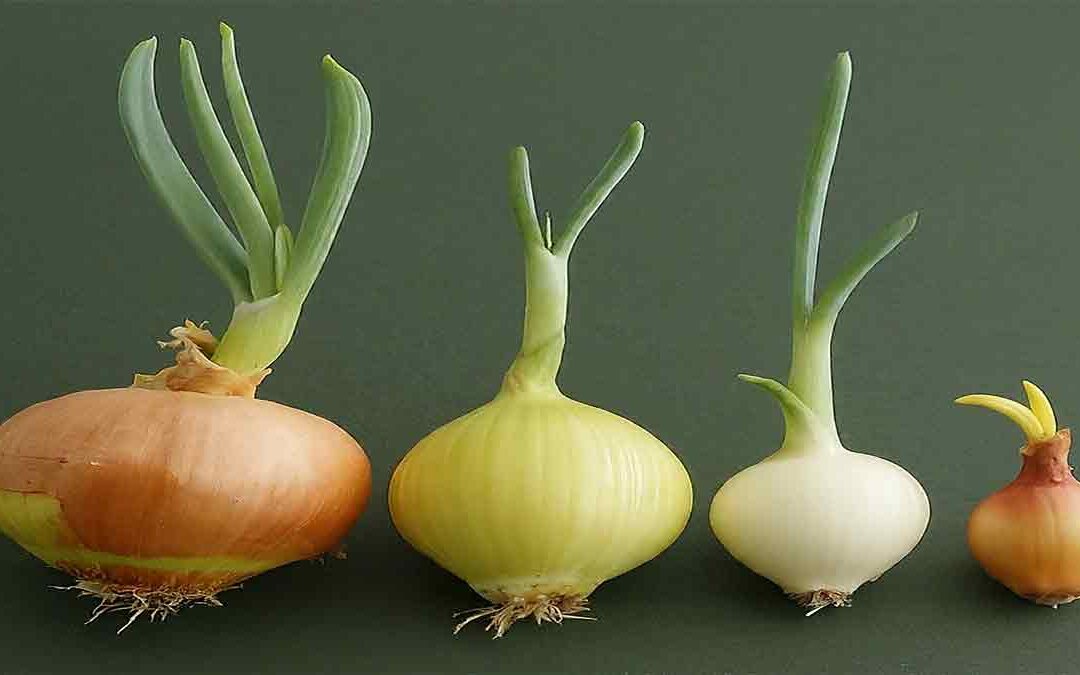Onions, with their pungent aroma and complex flavors, have been a culinary cornerstone for millennia. From the savory warmth of French onion soup to the tangy bite of pickled onions, these versatile bulbs elevate countless dishes. But have you ever considered the remarkable journey that onions undertake, from a tiny seed to a flavorful masterpiece?
In this comprehensive guide, we will embark on a captivating exploration of the complete onion life cycle, delving into each of the 14 Onion Growth Stages. Whether you’re a seasoned gardener or a budding enthusiast, understanding the intricacies of onion growth will empower you with the knowledge and skills to cultivate your own culinary gold.
1- Choosing Your Onion Varieties: Tailoring Your Onions to Your Garden
The first step on your onion-growing adventure is selecting the perfect varieties for your unique environment and culinary aspirations. Onions are categorized into three main types based on their day-length requirements, each with distinct characteristics:
- Short-Day Onions: These early-maturing varieties thrive in warmer climates with shorter daylight hours (10-12 hours). Popular short-day onion cultivars include Texas Grano 1015Y, Red Burgundy, and White Bermuda, known for their sweet and mild flavors.
- Long-Day Onions: Perfect for northern gardens with longer summer days, these onions require 14-16 hours of daylight to initiate bulbing. Long-day varieties like Copra, Walla Walla Sweet, and Alisa Craig are prized for their pungent flavor and excellent storage potential.
- Day-Neutral Onions: Adaptable to a wider range of climates, day-neutral onions form bulbs with moderate day length (12-14 hours). This versatile category includes Candy, Cabernet, and Redwing onions, offering a balance of sweetness and pungency.
Choosing the Right Variety for Your Region
To ensure a successful harvest, consult your local agricultural extension service (like the Texas A&M AgriLife Extension) or reputable seed companies (such as Johnny’s Selected Seeds) to identify the best onion varieties for your specific planting zone and growing conditions.
2- Preparing for Planting: Building a Strong Foundation for Your Onions
Onions, though relatively easy to grow, have specific needs that must be met for optimal growth. By investing a little effort in soil preparation, you’ll set the stage for a healthy and productive onion patch.
- Understanding Onion Soil Requirements: Onions thrive in well-draining soil with a slightly acidic pH, ideally between 6.0 and 6.8. Conduct a soil test to assess your soil’s composition and nutrient levels. Incorporating organic matter like compost or aged manure improves drainage, enhances fertility, and provides essential nutrients for healthy onion development.
- Preparing the Onion Bed: Whether you’re planting in raised beds, containers, or directly in the ground, ensure your planting area is well-prepared. Remove any weeds, rocks, or debris that could hinder root growth. Loosen the soil to a depth of at least 12 inches to promote good drainage and aeration.
- Choosing the Best Planting Method for Onions: Your planting method will depend on your preferences and resources.
- Seeds: Starting from seed is a cost-effective option that offers a wider variety of onion choices. However, it requires more time and attention, as seeds need to be started indoors or sown directly in the garden.
- Sets: Onion sets are small, immature bulbs that are easy to plant and mature faster than seeds. They are a popular choice for beginner gardeners.
- Transplants: These young onion seedlings offer a head start in the growing season, but they may be more expensive and require careful handling during transplanting.
Consider your experience level, available time, and budget when deciding which planting method suits you best.
3- Planting Your Onions: Bringing Your Onion Dreams to Life
Now that your soil is prepped and primed, it’s time for the exciting part: planting your onions! This Onion Growth Stage lays the foundation for a healthy and bountiful harvest, so let’s ensure we get it right.
Planting Seeds: Nurturing the Potential Within
Starting onions from seed is a rewarding (and economical!) way to grow a wider variety of onion types. However, it requires a bit more patience and attention to detail compared to other methods.
- Starting Seeds Indoors: For an early start, sow onion seeds indoors 8-10 weeks before the last frost. Use a seed-starting mix and keep them moist and warm (70-75°F). Harden off the seedlings before transplanting them outdoors after the last frost.
- Direct Sowing: You can also sow onion seeds directly into your prepared garden bed after the last frost. Plant them about 1/4 inch deep and 1-2 inches apart. Thin the seedlings to 4-6 inches apart once they reach a few inches tall.
Planting Sets: A Quick and Easy Option
Onion sets are small, immature bulbs that offer a convenient way to jumpstart your onion patch. They’re perfect for beginners and those seeking a faster harvest.
- Choosing Sets: Look for firm, disease-free sets about the size of a dime. Avoid any that are soft, moldy, or sprouting.
- Planting Depth: Plant sets about 1 inch deep and 4-6 inches apart. Make sure the pointed end is facing up.
Planting Transplants: Giving Your Onions a Head Start
Transplants are young onion seedlings that give you a head start in the growing season. While they may be pricier than seeds or sets, they can be a good option if you’re short on time or want to try more unique varieties.
- Handling Transplants: Handle transplants gently by their leaves, not the stems. Plant them at the same depth they were growing in their containers, spacing them 4-6 inches apart.
Timing and Spacing Considerations: Optimizing Growth
Timing is crucial when planting onions, as they have specific temperature and day length requirements.
- Spring Planting: In most regions, onions are planted in early spring, as soon as the ground can be worked. Check your local frost dates and plant accordingly.
- Fall Planting: In warmer climates, some onion varieties can be planted in the fall for an earlier harvest the following spring.
- Spacing: Space onion plants 4-6 inches apart in rows spaced 12-18 inches apart. This allows for adequate airflow and bulb development.
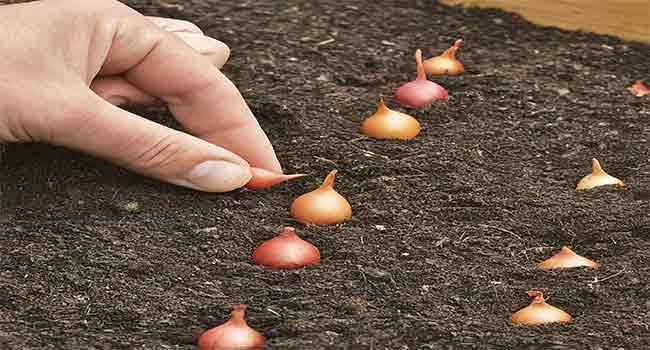
4- Seed Germination and Emergence: The First Signs of Life
After planting, the anticipation builds as you await the first signs of life from your onion seeds. This stage from Onion Growth Stages is a delicate one, and understanding the germination process is crucial for success.
Germination Requirements: Creating the Ideal Environment
Onion seeds need warmth, moisture, and light to germinate. According to the University of Minnesota Extension, the ideal soil temperature for onion seed germination is between 60-75°F. Keep the soil consistently moist but not waterlogged. A fine mist or gentle watering can is best for keeping the soil surface damp without disturbing the seeds. Onion seeds need light to germinate, so don’t bury them too deeply. A depth of 1/4 inch is sufficient.
Emergence: From Seed to Sprout
Germination typically takes 7-14 days, depending on the variety and environmental conditions. You’ll first notice a small white root emerging from the seed, followed by a green shoot pushing through the soil surface. This is an exciting moment, as it signifies the beginning of your onion’s journey.
Caring for Newly Emerged Seedlings: Tender Loving Care
Once your onion seedlings emerge, they’ll need a little extra attention to thrive:
- Watering: Keep the soil consistently moist but not soggy. Water gently to avoid dislodging the seedlings.
- Light: Ensure your seedlings receive adequate sunlight. If starting indoors, place them near a sunny window or under grow lights.
- Thinning: If you planted your seeds close together, thin them out to 4-6 inches apart once they have a few true leaves. This will give each plant enough space to grow and develop strong roots.
- Protection: Protect your young seedlings from pests like birds and slugs. You can use netting or row covers to shield them.
5- Developing True Leaves: The Building Blocks of Your Onion
As your onion seedlings continue to grow, they’ll start developing their first true leaves. This is an important milestone, as these leaves are essential for photosynthesis and energy production, fueling the onion’s growth and bulb development.
First True Leaves: A Sign of Progress
After the initial sprout emerges, you’ll soon notice the appearance of slender, cylindrical leaves. These are the onion’s first true leaves, and they mark a significant step in its development. Unlike the initial sprout, true leaves are more robust and capable of photosynthesis, the process by which plants convert sunlight into energy.
Importance of Leaf Development: The Powerhouse of Growth
The leaves of your onion plants are their powerhouses, responsible for producing the energy needed for bulb formation and overall plant growth. As your onions mature, the leaves will continue to multiply, creating a lush canopy that will eventually give way to the bulb.
Caring for Young Plants: Nurturing Growth
During this stage, it’s crucial to provide your young onions with the care they need to thrive:
- Watering: Maintain consistent soil moisture, watering deeply but infrequently. Avoid overwatering, which can lead to root rot.
- Fertilizing: Feed your onions with a balanced fertilizer to provide the nutrients they need for healthy growth. Consider using a slow-release fertilizer or applying liquid fertilizer every few weeks.
- Weed Control: Keep the area around your onion plants weed-free to minimize competition for nutrients and water.
- Pest and Disease Monitoring: Be vigilant for pests and diseases, such as onion maggots, thrips, and fungal diseases. Early detection and intervention are key to preventing major damage.
6- The Vegetative Growth Stage: Building the Foundation for a Bountiful Harvest
The vegetative growth stage from Onion Growth Stages is a period of rapid leaf development. Your onion plants will focus their energy on producing more leaves, which will ultimately contribute to the size and quality of the bulbs. This phase typically lasts several weeks, during which your onions will need consistent care and attention.
Rapid Leaf Growth: The Green Powerhouse
During this stage, you’ll be amazed at how quickly your onion plants grow. The leaves will multiply, becoming thicker and taller. This is a sign that your onions are healthy and actively photosynthesizing, converting sunlight into energy to fuel their growth.
According to the National Sustainable Agriculture Information Service (ATTRA), onion leaves are like solar panels, capturing energy from the sun to produce sugars that nourish the plant and contribute to bulb development.
Thinning and Weeding: Creating Space for Success
If you planted your onions densely, it’s important to thin them out during the vegetative growth stage. Thinning involves removing some of the smaller or weaker plants to provide adequate space for the remaining onions to develop fully. This will help prevent overcrowding, improve air circulation, and reduce the risk of disease.
To thin your onions, gently grasp the base of the unwanted plant and pull it out of the soil. Be careful not to disturb the roots of the remaining plants.
Additionally, regular weeding is essential to eliminate competition for resources. Weeds can steal water, nutrients, and sunlight from your onion plants, hindering their growth. Maintain a weed-free zone around your onions by hand-pulling or using a hoe.
Fertilizing for Vegetative Growth: Nourishing Your Onions
To support vigorous leaf growth, it’s important to provide your onions with adequate nutrition. Onions are considered heavy feeders, meaning they require a steady supply of nutrients throughout their growth cycle.
Apply a balanced fertilizer that is high in nitrogen, such as a 10-10-10 or 14-14-14 formula, to encourage leafy growth. You can use a granular slow-release fertilizer or apply liquid fertilizer every few weeks. Follow the recommended application rates on the fertilizer packaging to avoid over-fertilization.
Tips for Optimal Vegetative Growth:
- Watering: Maintain consistent soil moisture, especially during dry periods. Onions prefer deep watering to encourage root growth. Avoid overhead watering, as this can promote foliar diseases.
- Mulching: Apply a layer of organic mulch, such as straw or shredded leaves, around your plants to help retain soil moisture, suppress weeds, and regulate soil temperature.
- Pest and Disease Control: Continue to monitor your plants for pests and diseases, such as onion maggots, thrips, and fungal diseases. Early detection and intervention are key to preventing major damage. Consider using organic pest control methods like neem oil or insecticidal soap.
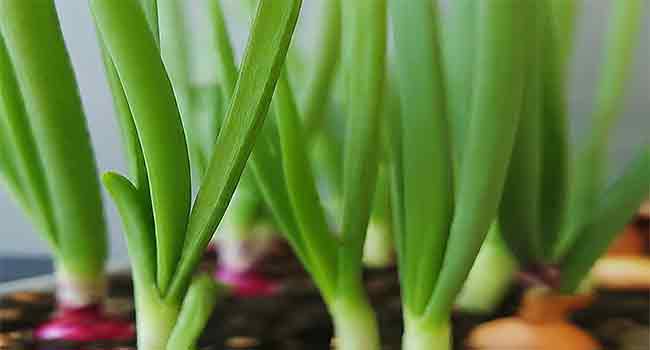
7- Bulb Initiation: The Magic Begins Beneath the Surface
As summer progresses, your onion plants will enter the most exciting phase of their life cycle – bulb initiation. This is where the magic truly happens, as those previously small bulbs transform into plump, flavorful spheres ready for your culinary creations.
Triggering Bulb Formation: The Role of Day Length and Temperature
Bulb initiation is primarily triggered by day length, with different onion varieties requiring specific durations of sunlight to start bulbing.
- Short-Day Onions: These onions are sensitive to day length and initiate bulbing when days reach 10-12 hours long. They typically mature faster and are well-suited for warmer climates with shorter growing seasons.
- Long-Day Onions: These onions require longer days, typically 14-16 hours of daylight, to trigger bulb formation. They are ideal for cooler climates with extended summer days.
- Day-Neutral Onions: These adaptable onions are less sensitive to day length and can bulb up under a wider range of conditions, making them suitable for various climates.
Temperature also plays a role in bulb initiation, with cooler temperatures generally favoring bulb development.
Early Signs of Bulbing: A Subtle Shift in Growth
As your onion plants approach the bulbing stage, you may notice subtle changes in their growth. The leaves may start to thicken at the base, and the central stalk may begin to swell slightly. These are early indicators that your onions are preparing to focus their energy on bulb development.
Supporting Bulb Initiation: Setting the Stage for Success
To ensure successful bulb initiation, here are a few key tips:
- Maintain Consistent Moisture: Water your onion plants regularly, especially during dry periods, to ensure the soil remains evenly moist.
- Monitor Nutrient Levels: Onions require adequate nutrients, particularly phosphorus and potassium, to support bulb formation. Apply a balanced fertilizer according to package directions.
- Protect from Pests and Diseases: Keep a watchful eye out for pests and diseases that could damage your plants and hinder bulb development. Implement preventative measures and treat any problems promptly.
8- Early Bulb Development: Nurturing the Growing Bulbs
Once bulb initiation is underway, your onion plants will enter a period of rapid bulb growth. During this phase, the bulbs will start to swell and expand, gradually taking on their characteristic shape.
Initial Bulb Growth: A Glimpse of the Future Harvest
As the bulbs begin to develop, you’ll notice the base of the plant thickening and the leaves becoming more upright. The bulbs will gradually increase in size, drawing energy from the leaves and nutrients from the soil.
Nutrient and Water Requirements for Early Bulb Development
Proper nutrition and watering are crucial during this stage to ensure healthy bulb development. Onions require adequate amounts of phosphorus and potassium for bulb growth. Continue to water your plants regularly, but be careful not to overwater, as this can lead to bulb rot.
Protecting Young Bulbs from Pests and Diseases
Onion plants are vulnerable to various pests and diseases during the early bulb development stage. Some common culprits include onion maggots, thrips, and fungal diseases. Implement preventive measures like crop rotation, companion planting (planting onions with carrots can be beneficial), and applying organic pest control methods to protect your growing bulbs.
9- Bulb Swelling and Development: The Growth Spurt
The bulb swelling stage is where the real magic happens. Your onion plants will channel their energy into expanding those bulbs, transforming them from small nubs into plump, juicy orbs.
Rapid Bulb Growth: A Race Against Time
During this phase, the bulbs will experience exponential growth, drawing energy from the leaves and nutrients from the soil. You’ll notice the base of the plant thickening considerably as the bulbs expand. This is a crucial time to ensure your plants have access to ample sunlight, water, and nutrients.
Factors Affecting Bulb Size: Nurturing Jumbo Onions
Several factors influence the size of your onion bulbs. Understanding these key elements will help you optimize your growing conditions and achieve a bountiful harvest:
- Day Length: Ensure your chosen varieties receive the appropriate amount of daylight based on their classification (short-day, long-day, or day-neutral).
- Temperature: Cooler temperatures generally favor bulb growth. If you’re growing long-day onions in a warm climate, consider providing shade during the hottest part of the day.
- Soil Fertility: Rich, fertile soil with adequate nutrients, particularly phosphorus and potassium, is essential for large, healthy bulbs. Regular fertilization with a balanced fertilizer will help ensure your onions have the resources they need to thrive.
- Water Availability: Consistent moisture is crucial for bulb expansion. Water your plants deeply but infrequently, allowing the soil to dry slightly between waterings to prevent root rot.
Supporting Bulb Development: Tips for Success
Here are a few additional tips to help your onion bulbs reach their full potential:
- Mulching: Apply a layer of organic mulch, such as straw or shredded leaves, around your plants to help retain soil moisture, suppress weeds, and regulate soil temperature.
- Pest and Disease Control: Continue to monitor your plants for pests and diseases, taking prompt action if any problems arise.
- Avoid Over-Fertilizing: While onions need nutrients for bulb development, over-fertilizing, especially with nitrogen, can lead to excessive foliage growth at the expense of bulb size. Use a fertilizer specifically formulated for onions or root vegetables.
10- Harvesting Your Onions: Reaping the Rewards of Your Labor
The culmination of your onion-growing journey is finally here: harvest time! As the days shorten and the temperatures cool, your onion plants will signal that they’re ready to be gathered and enjoyed. Harvesting and curing your onions properly is essential to ensure they store well and retain their flavor for months to come.
Signs of Maturity: Knowing When to Harvest
According to the National Gardening Association, onions are ready for harvest when about 50% of the tops have fallen over and the necks (the area where the leaves meet the bulb) have started to dry. The outer skin of the bulbs should also be dry and papery.
Harvesting Techniques: Gentle Handling for Optimal Storage
Harvesting onions requires a gentle touch to avoid bruising or damaging the bulbs, which can lead to spoilage.
- Loosen the Soil: Use a garden fork or spade to gently loosen the soil around the onions, taking care not to pierce the bulbs.
- Lift the Bulbs: Carefully lift the onions from the ground, grasping them by the neck. Avoid pulling on the tops, as this can damage the bulbs.
- Brush Off Excess Soil: Gently brush off any excess soil from the bulbs, but don’t wash them yet. They need to dry thoroughly before storing.
Curing: The Key to Long-Term Storage
Curing is the process of drying onions to prepare them for storage. It helps toughen the outer skin, prevent rot, and enhance flavor. The University of Minnesota Extension recommends curing onions for 2-4 weeks, depending on the weather conditions.
- Drying: Spread the onions out in a single layer in a warm, dry, well-ventilated area. Avoid direct sunlight, which can cause sunburn.
- Curing Time: The necks should be completely dry and papery before storing.
Storing Your Onions: Preserving Your Harvest
Once cured, your onions can be stored for months.
- Ideal Storage Conditions: Store onions in a cool, dark, dry place with good air circulation. Temperatures between 32-40°F are ideal. A root cellar or a cool, dark basement are good options.
- Storage Options: You can store onions in mesh bags, crates, or baskets. Avoid storing them in plastic bags, as this can trap moisture and lead to spoilage.
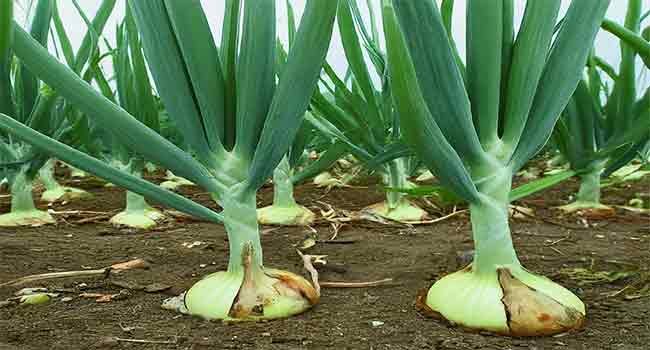
11- Post-Harvest Care: Ensuring the Longevity of Your Harvest
After you’ve harvested and cured your onions, there are still a few steps to take to ensure they remain in optimal condition for storage.
Cleaning and Sorting Harvested Onions:
- Remove any remaining dirt or debris from the onions after curing.
- Sort through your harvest and discard any onions that are damaged, diseased, or showing signs of rot.
- If you notice any onions with thick necks that haven’t dried down properly, they might not store well. It’s best to use these onions first.
Preparing Onions for Storage or Use:
- Trim the roots and tops, leaving about an inch of stem attached. This helps prevent moisture from entering the bulb and causing rot.
- If you plan to use your onions soon, you can store them in a cool, dark place like a pantry or refrigerator.
- For long-term storage, consider braiding your onions or hanging them in mesh bags in a cool, dry, and well-ventilated location.
Troubleshooting Storage Issues:
- Sprouting: If your onions start to sprout, it’s a sign that they’re getting too much light or warmth. Move them to a cooler, darker location.
- Rotting: Soft spots or mold indicate rotting. Discard any affected onions to prevent the rot from spreading.
- Shriveling: Shriveling is a sign of dehydration. Ensure your storage area is cool and dry, and avoid storing onions near fruits that release ethylene gas, which can accelerate spoilage.
12- Flowering and Seed Production: The Cycle Continues
While most gardeners harvest onions for their bulbs, these remarkable plants have another fascinating stage in their life cycle: flowering and seed production. If you’re interested in saving seeds for future generations, understanding this stage is crucial.
Flowering Stalks: The Emergence of a New Generation
If you leave some of your onion plants in the ground after the bulbs mature, they’ll eventually send up tall flowering stalks. These stalks, also known as scapes, bear clusters of small, white or pink flowers.
Pollination and Seed Formation: Nature’s Reproductive Magic
The flowers on the onion scapes need to be pollinated to produce seeds. This can be done by insects, wind, or even by hand. Once pollinated, the flowers will develop into seed pods containing numerous tiny black seeds.
Seed Saving: Preserving Onion Heritage
If you’re interested in saving seeds for future generations, allow the seed pods to mature fully on the plant. Once dry, carefully collect the pods and extract the seeds. Store the seeds in a cool, dry place until you’re ready to plant them next season. Remember to label your seeds with the variety and date of harvest.
13. Flowering and Seed Production: The Cycle Continues
While most gardeners harvest onions for their bulbs, these remarkable plants have another fascinating stage in their life cycle: flowering and seed production. If you’re interested in saving seeds for future generations, understanding this stage is crucial.
Flowering Stalks: The Emergence of a New Generation
If you leave some of your onion plants in the ground after the bulbs mature, they’ll eventually send up tall flowering stalks. These stalks, also known as scapes, bear clusters of small, white or pink flowers. This stage typically occurs in the second year of growth for most onions.
Pollination and Seed Formation: Nature’s Reproductive Magic
The flowers on the onion scapes need to be pollinated to produce seeds. This can be done by insects like bees and butterflies, wind, or even by hand if you’re growing onions in a controlled environment. Once pollinated, the flowers will develop into seed pods containing numerous tiny black seeds.
Seed Saving: Preserving Onion Heritage
If you’re interested in saving seeds for future generations, allow the seed pods to mature fully on the plant. Once dry and brown, carefully collect the pods and extract the seeds. According to Seed Savers Exchange, a non-profit organization dedicated to preserving heirloom seeds, onion seeds can be stored for 3-4 years if kept in a cool, dry place. Remember to label your seeds with the variety and date of harvest.
14. Senescence and Completion of the Life Cycle: Nature’s Final Bow
After flowering and seed production, the onion plant will naturally enter senescence, a period of decline and eventual death. The leaves will yellow and wither, and the bulb will start to decompose. This is a natural part of the plant’s life cycle, marking the end of one generation and the potential beginning of another through the seeds it has produced.
Senescence: The Natural Decline
Senescence is a complex process involving the breakdown of chlorophyll (the green pigment in plants) and the redistribution of nutrients within the plant. As the onion plant senesces, it gradually loses its vigor and eventually dies back completely.
Clearing the Garden Bed: Making Way for New Growth
Once your onion plants have senesced, it’s time to clear the garden bed. Remove the dead plants and any remaining debris. This will help prevent the spread of diseases and pests, and prepare the soil for future plantings. If you’ve saved seeds, you can now start the cycle anew by planting them next season.
Reflections on the Onion Life Cycle: The Beauty of Growth and Renewal
As you complete this journey through the onion’s life cycle, take a moment to appreciate the wonder of nature’s processes. From a tiny seed to a flavorful bulb, and ultimately to the production of new seeds, the onion’s journey is a testament to the resilience and interconnectedness of life. By understanding and respecting each stage of this cycle, we can cultivate not only delicious onions but also a deeper appreciation for the natural world.
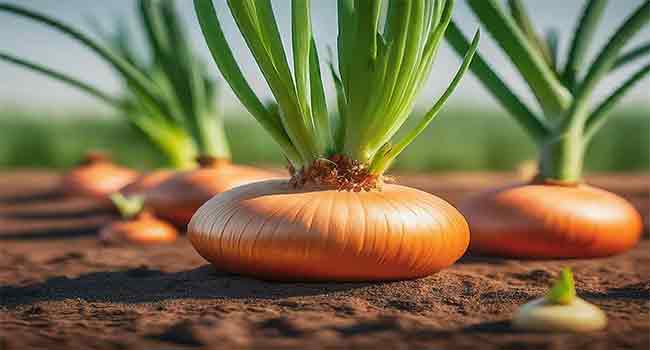
Frequently Asked Questions About Onion Growth Stages
- How long does it take to grow an onion from seed to harvest?
The total time to grow an onion from seed to harvest can range from 110 to 175 days, depending on the variety and your growing conditions. Short-day onions generally mature faster than long-day onions.
- What are the health benefits of eating onions?
Onions are packed with nutrients and offer numerous health benefits. They are a good source of vitamin C, fiber, and antioxidants. Onions have been linked to improved heart health, reduced inflammation, and even cancer prevention.
- How can I tell when my onions are ready to harvest?
Look for the following signs that your onions are ready to harvest:
- At least 50% of the tops have fallen over.
- The necks of the onions are soft and pliable.
- The outer skin of the bulbs is dry and papery.
- What are the best conditions for onion growth?
Onions thrive in full sun and well-draining soil with a slightly acidic pH (6.0-6.8). They require consistent moisture but are susceptible to root rot if the soil is too wet. Regular fertilization with a balanced fertilizer is also important.
- How do I store onions after harvest?
After harvesting, cure your onions in a warm, dry, well-ventilated area for 2-4 weeks. Once cured, store them in a cool, dark, dry place with good air circulation. Mesh bags, crates, or baskets are ideal for storage. Avoid storing onions in plastic bags, as this can trap moisture and lead to spoilage.
- Can I save seeds from my onions?
Yes, you can save seeds from onions that have been allowed to flower and produce seed pods. Once the pods are dry and brown, carefully collect them and extract the seeds. Store the seeds in a cool, dry place until you’re ready to plant them next season.
- Why are my onions bolting (flowering) before forming bulbs?
Bolting is often caused by stress, such as exposure to cold temperatures or inconsistent watering. Choose onion varieties that are suited to your climate and provide consistent care to prevent bolting.
- What are some common pests and diseases that affect onions?
Onions can be susceptible to pests like onion maggots, thrips, and aphids, as well as diseases like downy mildew and purple blotch. Practice good garden hygiene, rotate crops, and use organic pest control methods to minimize these problems.
- Can I grow onions in containers?
Yes, onions can be successfully grown in containers. Choose a container that is at least 12 inches deep and wide, and use a well-draining potting mix. Make sure the container has drainage holes to prevent water logging.

